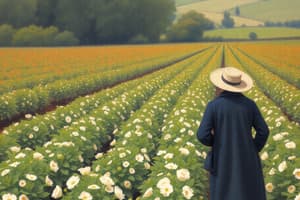Podcast
Questions and Answers
Which practice involves crossing plants with desirable traits and selecting the best offspring?
Which practice involves crossing plants with desirable traits and selecting the best offspring?
- Hydroponics
- Vertical farming
- Crop rotation
- Crop improvement (correct)
What is the main benefit of precision agriculture?
What is the main benefit of precision agriculture?
- Enhanced pest cycles
- Increased soil erosion
- Optimized irrigation and fertilization (correct)
- Reduced water infiltration
Legumes in crop rotation are beneficial primarily for:
Legumes in crop rotation are beneficial primarily for:
- Improving soil erosion
- Enhancing water infiltration
- Breaking pest cycles
- Fixing nitrogen (correct)
What is a significant challenge associated with modern crop cultivation techniques like hydroponics and vertical farming?
What is a significant challenge associated with modern crop cultivation techniques like hydroponics and vertical farming?
Which technique is a soil-less form of crop cultivation using nutrient-rich water or liquid solutions?
Which technique is a soil-less form of crop cultivation using nutrient-rich water or liquid solutions?
How does vertical farming differ from traditional field agriculture?
How does vertical farming differ from traditional field agriculture?
What is the main purpose of crop cultivation in agriculture?
What is the main purpose of crop cultivation in agriculture?
How do farmers and scientists contribute to crop cultivation?
How do farmers and scientists contribute to crop cultivation?
How do geography and climate impact crop cultivation?
How do geography and climate impact crop cultivation?
Which of the following is an example of a perennial crop?
Which of the following is an example of a perennial crop?
In which region would you most likely find rice being cultivated based on the text?
In which region would you most likely find rice being cultivated based on the text?
Flashcards are hidden until you start studying
Study Notes
Cultivating a Sustainable Future: Understanding Crop Cultivation in Agriculture
Crop cultivation is a cornerstone in the world of agriculture, where plants are grown intentionally to provide food, fodder, raw materials, and more. This practice, which dates back to the dawn of civilization, has evolved dramatically over the millennia, shaping our world as we know it today.
The Basics of Crop Cultivation
Crop cultivation involves selecting, planting, and nurturing specific plant species, known as crop plants, to produce goods that benefit humanity. Farmers and scientists work together to understand the genetics, biology, and ecology of these plants to optimize their growth, yield, and resistance to pests and diseases.
Crop cultivation is also influenced by geography, climate, and human activities. These factors shape the crops grown in various regions, from corn in the American Midwest and wheat in the European plains to rice in Southeast Asia and coffee in Central America.
Crop Classification
Crops are generally categorized into annuals or perennials.
- Annual crops are grown and harvested within a single growing season, with some examples including corn, potatoes, and lettuce.
- Perennial crops grow and produce for several years, like apples, asparagus, and bananas.
Crop Rotation
Crop rotation is a sustainable agricultural practice that involves the periodic planting of different crops in the same area to improve soil fertility, reduce pest and disease pressure, and enhance nutrient availability. Each crop in the rotation provides specific benefits, such as fixing nitrogen (legumes) or breaking pest cycles (brassicas). Crop rotation also helps to reduce soil erosion and improve water infiltration.
Crop Improvement
Crop improvement, also known as plant breeding, is a centuries-old practice that involves the development of new plant varieties with improved characteristics, such as higher yields, better disease resistance, and increased nutritional content. This process involves crossing plants with desirable traits and selecting the best offspring. Other techniques, such as marker-assisted selection and genome editing, have become increasingly popular for crop improvement in recent years.
Modern Techniques and Challenges
Modern techniques like precision agriculture, hydroponics, and vertical farming are helping to push the boundaries of crop cultivation, addressing challenges related to climate change, water scarcity, and population growth.
- Precision agriculture uses technology to monitor and manage crop fields at a high resolution, allowing farmers to optimize irrigation, fertilization, and crop rotation strategies.
- Hydroponics is a soil-less form of crop cultivation that uses nutrient-rich water or other liquid solutions to grow plants, often in controlled environments.
- Vertical farming is the practice of growing plants in vertically stacked layers, using less space and fewer resources than traditional field agriculture.
These techniques, while promising, do not come without challenges. For example, there are concerns about the high cost of technology and the need for specialized knowledge, which may limit their accessibility for small-scale farmers.
Conclusion
Crop cultivation is a dynamic and multifaceted field that is critical to global food security and environmental sustainability. By understanding the basics of crop cultivation, we can appreciate the importance of this practice and its role in shaping our world. As new techniques emerge, it will become increasingly important to balance the benefits of these innovations with their potential drawbacks, ensuring that crop cultivation continues to serve as a driving force for a sustainable future.
Studying That Suits You
Use AI to generate personalized quizzes and flashcards to suit your learning preferences.



